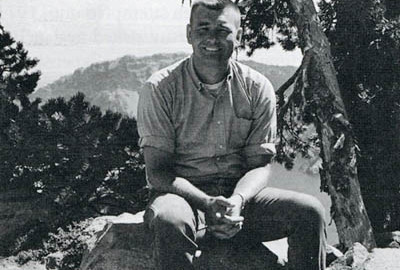So you were down on the lake doing research?
My last summer of work there was in ’85, then Gary took over. In ’86 I made one field trip with Gary down there to compare our photometers. Gary bought a new photometer, and I still had the one I had been using for several years. We thought let’s compare these
to see how they read subsurface light. I remember we taped the two sea cells together so that they would go down exactly the same. That was my last field trip and I didn’t go back until the summer of ’95 with some friends from Austria.
How did the AAAS article come about?
I kept up my activism, and every chance I got I would write an editorial in the paper, maybe three or four of them. They had a meeting [of the AAAS] in Corvallis in ’89 and we were all asked to give papers (28). I went down and gave a paper and I don’t think anybody really rebutted my views at the meeting. Perhaps this was because I was only suggesting that this was happening. I never claimed that any decline of optical properties was happening for a fact. All I said was that we have data suggesting that the optical properties have changed. We also have data from one of these springs, in fact, several of these springs under the lodge showing them to be enriched with nitrates — which is a common component of sewage (29). Nitrates do not adhere to soil particles like phosphorous does. It’s very mobile through soils. But this is still hypothetical. I made that clear. When it came time to publish the papers in the proceedings of the symposium, the Park Service tried to keep my paper out of it. Fortunately, the senior editor, Ellen Drake, who’s an oceanographer at OSU, publicly stated that there would be no censorship of this book. The Park Service argued vehemently against including my paper, but she said well, it stays. For better or worse my paper got published (30). The Park Service tried to censor it and that’s not in the spirit of good science. I think you need to look at all facets of this argument. You need to look at those who are your adversaries as well as advocates, the team players. My paper got published. Then in 1992, on the park’s 9oth anniversary, I attended a symposium at Southern Oregon State College and gave another paper (31). There were a couple of naysayers in the audience who challenged me, but 1 just reiterated my usual position about this being a possibility. By that time, of course, the park had connected their sewer line to the cafeteria [in 19911 and were piping the sewage to the Munson Valley Lagoons. In about ’93 or ’94 the new Superintendent, David Morris, denied that sewage ever reached the lake. This was even published in the newspaper (32). He just said it never happened, which was infuriating to me, because in 1987 the Park Service made a statement that there was a good possibility that sewage was going in the lake (in an environmental impact document they were doing for improvements in Rim Village) (33). So it seems like I sort of became “an enemy of the people.” Who wrote that?


